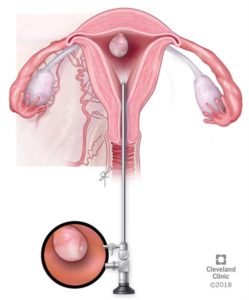Hysteroscopy
Does your uterus bleed abnormally during menstruation or even after menopause? Did you suspect anything from unnatural bleeding? It could be because of hysterosalpingography, uterus septums, scar tissues or anything.
If you want to diagnose and treat abnormalities effectively, visit New Hope to find the right solution from the experts. At New Hope, you can expect world-class treatment of hysteroscopy and ART solutions. From our previous experience, we are sure to help you heal from it.

Difference Between Diagnostic and Operative Hysteroscopy
Diagnostic Hysteroscopy
Operative Hysteroscopy
Benefits of Hysteroscopy
Hysteroscopy is an outpatient treatment that helps to diagnose and then treat the conditions of abnormal bleeding. Patients who undergo hysteroscopy do not have to stay in the hospital for longer periods as the recovery time is pretty much shorter. Plus, the need for pain medications is also less after the surgery.
In addition, one can avoid bare abdominal surgery and hysterectomy.
Who are the best candidates for Hysteroscopy
- Women with abnormal Pap test results
- Women who bleed after menopause
- Women having two or more miscarriages
- Women who are failing to get pregnant naturally
- IUD is out of a specific place
- Presence of polyps, fibroids or scars on the uterus
Procedure of Hysteroscopy
- Before the procedure, the doctor often prescribes a sedative for your relief
- Then just before the operation, anesthesia will be done.
- During the operation, the doctor dilates the cervix of the patient to enable the insertion of the hysteroscope.
- The doctor then inserts a hysteroscope between the vagina and cervix in the uterus
- Following this, a special liquid solution is inserted through the hysteroscope into the uterus. This ensures to expand the cervix for clearing out the presence of mucus or blood.
- Next, with the help of a light that sources through the same hysteroscope, the doctor succeeds in seeing the uterus and the entrance.
- After examination, if needed, the doctor performs surgery by inserting small equipment through the hysteroscope into the uterus.
- The surgery can continue for as little as five minutes or last for over an hour, depending on the diagnostic and operative type of hysteroscopy. Typically, diagnostic hysteroscopy lasts shorter than the operative
What is Hysteroscopy

Hysteroscopy is an essential step if you are undergoing any fertility evaluation or looking for an IVF. Hysteroscopy helps to diagnose and treat the problems associated with your uterus. During unsuccessful IVF attempts, hysteroscopy is advised to determine underlying issues related to the uterus. It allows your doctor to diagnose the intrauterine pathology and decide the best line of treatment.
During IVF, it is essential to check for any intrauterine defect that can interfere with the implantation. Hysteroscopy enables better evaluation of any such issues and also improves your chances of conception.
Hysteroscopy is the procedure that allows your doctor to look inside your uterus in order to diagnose and treat any abnormality inside the uterus. Hysteroscopy is done with thin telescope. It’s a day care procedure, does not require admission.
Diagnostic Hysteroscopy – This is used to diagnose the problem in the uterus. In hysteroscopy we can diagnose fibroids, polyp, adhesions and septum.
Operative Hysteroscopy – If an abnormal condition was detected during the diagnostic hysteroscopy, an operative hysteroscopy can often be performed at the same time, avoiding the need for a second surgery.
